

|
|
|
1874
With Arrows
Variety 114
Obverse 6: Missing Right Arrow, High Date, Slight Upward Slope, Left Arrow DR -1C
Reverse N: Die Cracks
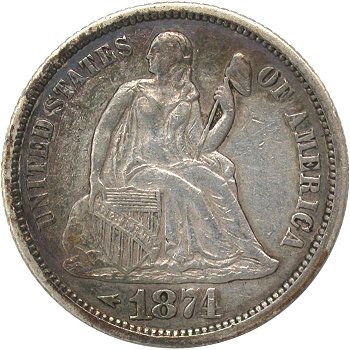
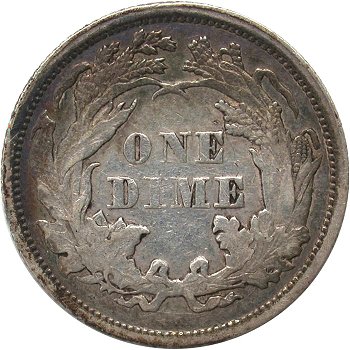
Obverse 6 Reverse N
Obverse Diagnostic Point(s)
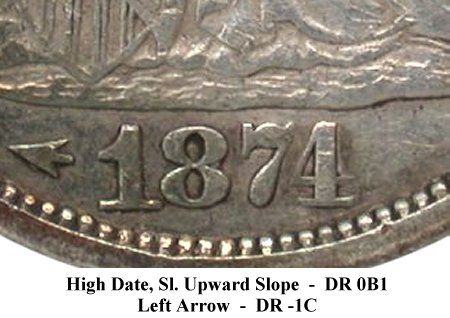
Comments: During early 2006, an 1874 With Arrows dime appeared on Teletrade. Both Tim Irvin and I noticed that the right arrow was missing, leading to speculation that this coin was struck from the same obverse die that produced the F-106 variety, which is the excessively rare missing or polished arrows variety. Tim purchased the coin and was kind enough to forward this intriguing dime along for additional study and for development of an explanation as to the missing right arrow but not the left arrow. After studying both Tim's coin and the F-106 plate coins for several days, the following observations and conclusions have been made;
1. The date punch on both coins is oblique from left to right. The 1 digit has the deepest punch while the 4 digit has the shallowest impression. The separate illustrations of the 18 and 74 digits taken from both coins (below) will reinforce this observation.
2. Examination of 1874 With Arrows obverse dies indicates that all four digits of the date were punched together by using a logotype punch with the arrows being added separately. When I study the Tim Irvin plate coin, an immediate observation jumps out. The fact that the left arrow is boldly punched and the right arrow is nearly missing matches the left to right oblique natured of the date punch. Clearly the left arrow is the strongest date digit/arrows element on this coin while the 4 digit and the right arrow are the weakest. Therefore a left to right punch depth alignment exists between the arrows and the date digits on Irvin's coin.
3. Based on the observation made in #2, might it be possible that the Philadelphia mint was experimenting with a new ganged date and arrows punch in 1874? The evidence from the Irvin coin would support that conclusion given the clear left (deepest) to right (shallowest) appearance of the date and arrows.
F-114 With Missing Right Arrow
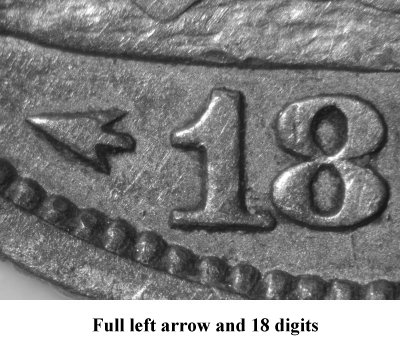
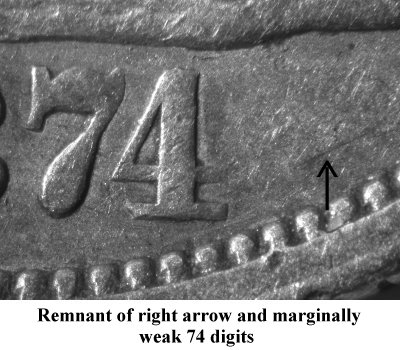
F-106 With Missing Left and Right Arrows
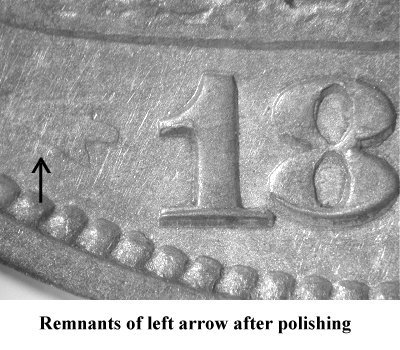
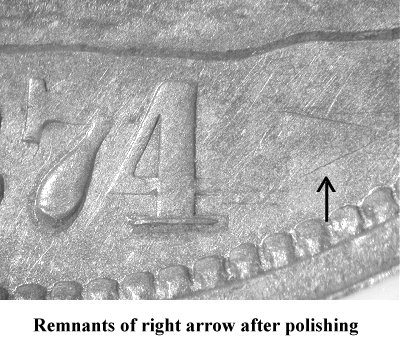
4. If the conclusion of experimentation with a ganged date and arrows punch is valid, then how can the source of the missing left arrow on F-106 be explained? At this time, I cannot offer a theory that is fully supported by the visual evidence acquired from two coins. Some obervations and commentary is that direction are as follows:
The Obverse 6 die has be reworked between the striking of the F-114 and the F-106 plate coins. Previous study of the F-106 plate coin revealed an obverse die that is prooflike and struck from a polished die. When I compare the strength of the device elements between the two coins, it does appear that the F-114 coin was struck before the obverse die was polished. Therefore I have listed the Irvin F-114 coin as being in an earlier die state than the Fortin F-106 coin.
What remains unexplained if the cause for the missing left arrow on the F-106 variety. Yes, the lapping of Obverse 6 would have removed a portion of the left arrow but not to the extent that we see on the F-106 plate coin, given the residual strength of the 18 digits. Another avenue to explore is the possibility that a greased die was the source for the missing left arrow. I would enjoy hearing other theories from readers as to the source of the missing arrows left and right arrows on F-106.
Finally, the reverse die of F-114 is listed as a new die due to the die cracks in the right wreath. No other 1874 With Arrows dimes in my collection matches the reverse cracks on Tim's coin. For completeness, it should also be mentioned that Tim's coin exhibits considerable doubling in the left wreath. The doubling is shelf like and is most likely strike doubling.
Plate Coin: Courtesy of Tim Irvin Collection, EF45
August 14, 2012 Update
David Poliquin contacted the author during July 2012 and indicated that another 1874 With Arrows F-114 had been located. David remarked that the right arrow was visible on his EF45 example and requested a confirmation that the dime was indeed the F-114 variety. Followings are images from David's 1874 With Arrows dime.
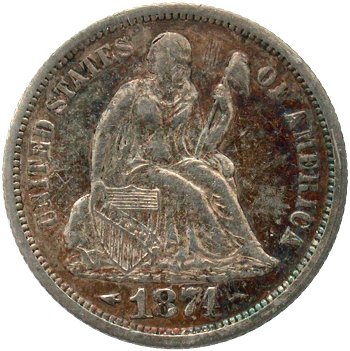
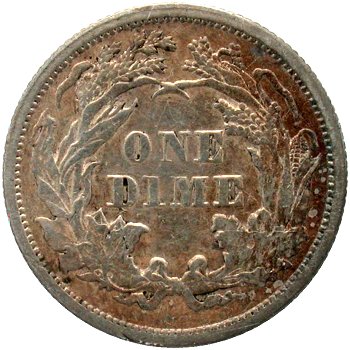
Upon completing a microscope inspection of the date area, it was concluded that David's 1874 dime was another F-114 specimen. The combination date and arrows logotype punch theory remains valid with the left arrow and 18 digits being strongly punched and the 4 digit and right arrow being shallow in the die face due to oblique punch. The 187 date digits do not show repunching as seen for F-106 variety die state.
The reverse on David Poliquin's dime has die cracks in the right wreath in same locations as the Tim Irvine coin.